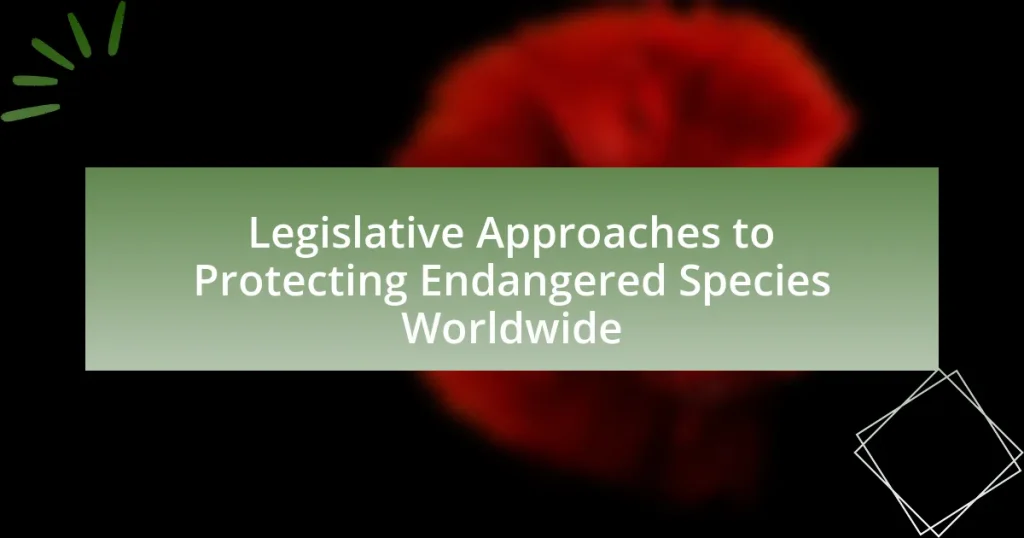Legislative approaches to protecting endangered species worldwide encompass a range of laws and regulations designed to conserve biodiversity and prevent extinction. Key frameworks include the Endangered Species Act in the United States and the Convention on International Trade in Endangered Species (CITES), which regulate species protection and trade. The article explores how different countries implement these laws, the essential components of effective legislation, and the influence of cultural and economic factors on conservation efforts. It also addresses the challenges faced in enacting legislation, the consequences of inadequate protections, and the role of international cooperation in enhancing legislative effectiveness. Additionally, it highlights successful examples of legislation and innovative strategies that leverage technology and data to improve conservation outcomes.

What are Legislative Approaches to Protecting Endangered Species Worldwide?
Legislative approaches to protecting endangered species worldwide include the establishment of laws and regulations that aim to conserve biodiversity and prevent species extinction. Key examples include the Endangered Species Act in the United States, which provides for the conservation of threatened and endangered plants and animals and their habitats, and the Convention on International Trade in Endangered Species of Wild Fauna and Flora (CITES), which regulates international trade of endangered species to ensure their survival. These legislative frameworks are supported by scientific research and data, such as the International Union for Conservation of Nature’s Red List, which assesses the conservation status of species globally, highlighting the need for legal protections to mitigate threats like habitat loss and poaching.
How do different countries implement these legislative approaches?
Different countries implement legislative approaches to protecting endangered species through a combination of national laws, international treaties, and conservation programs. For instance, the United States enforces the Endangered Species Act, which provides for the protection of species and their habitats, while also requiring federal agencies to ensure that their actions do not jeopardize listed species. In contrast, the European Union employs the Habitats Directive, which mandates member states to create protected areas and maintain biodiversity. Additionally, countries like India utilize the Wildlife Protection Act, which prohibits hunting and trade of endangered species, and establishes protected areas for their conservation. These legislative frameworks are often supported by international agreements such as the Convention on International Trade in Endangered Species (CITES), which regulates trade to prevent species extinction.
What are the key components of effective legislation for endangered species?
Effective legislation for endangered species includes key components such as clear definitions of endangered species, habitat protection measures, enforcement mechanisms, and public engagement strategies. Clear definitions ensure that the species in need of protection are accurately identified, which is crucial for targeted conservation efforts. Habitat protection measures, such as the establishment of protected areas, are essential to safeguard the ecosystems that support these species. Enforcement mechanisms, including penalties for violations, are necessary to deter illegal activities that threaten endangered species. Public engagement strategies, such as education and community involvement, foster support for conservation initiatives and promote awareness of the importance of biodiversity. These components collectively enhance the effectiveness of legislation aimed at protecting endangered species.
How do cultural and economic factors influence these legislative approaches?
Cultural and economic factors significantly influence legislative approaches to protecting endangered species worldwide. Cultural values shape public perception and support for conservation efforts, as communities with strong ties to their natural environment are more likely to advocate for protective legislation. For instance, indigenous cultures often emphasize the importance of biodiversity, leading to stronger local advocacy for species protection. Economically, the financial implications of conservation policies can drive legislative action; regions that rely on ecotourism may implement stricter protections to maintain biodiversity, which in turn supports their economy. A study by the World Wildlife Fund indicates that countries with robust conservation laws often have higher levels of public engagement and economic investment in sustainable practices, demonstrating the interplay between cultural appreciation for nature and economic incentives in shaping effective legislative frameworks.
Why is legislation crucial for the protection of endangered species?
Legislation is crucial for the protection of endangered species because it establishes legal frameworks that regulate activities threatening their survival. These laws, such as the Endangered Species Act in the United States, provide mechanisms for habitat protection, species recovery plans, and penalties for violations. For instance, the U.S. Fish and Wildlife Service reported that species listed under the Endangered Species Act have a higher recovery rate compared to those without legal protection, demonstrating the effectiveness of legislation in conserving biodiversity.
What role does legislation play in conservation efforts?
Legislation plays a critical role in conservation efforts by establishing legal frameworks that protect endangered species and their habitats. These laws, such as the Endangered Species Act in the United States, provide mechanisms for the identification, protection, and recovery of threatened species, ensuring that conservation actions are enforced and funded. For instance, the Endangered Species Act has led to the recovery of species like the American bald eagle, which was removed from the endangered list due to successful legislative protections.
How does legislation impact biodiversity and ecosystem health?
Legislation significantly impacts biodiversity and ecosystem health by establishing legal frameworks that protect endangered species and their habitats. For instance, the Endangered Species Act in the United States has led to the recovery of numerous species, such as the bald eagle and the American alligator, by prohibiting actions that harm these species and their ecosystems. Additionally, laws regulating pollution and land use contribute to healthier ecosystems by reducing habitat destruction and promoting conservation efforts. Research indicates that effective legislation can lead to increased biodiversity, as seen in protected areas where species populations rebound due to legal protections.
What challenges do countries face in enacting effective legislation?
Countries face significant challenges in enacting effective legislation, primarily due to political, economic, and social factors. Political instability can hinder the legislative process, as governments may lack the continuity needed to implement long-term policies. Economic constraints often limit funding for enforcement and compliance, making it difficult to uphold laws effectively. Additionally, social resistance, including public opposition or lack of awareness about the importance of protecting endangered species, can impede the passage of necessary legislation. For instance, in many regions, local communities may prioritize immediate economic benefits over conservation efforts, leading to conflicts that complicate legislative initiatives.
How do political and social factors hinder legislative progress?
Political and social factors hinder legislative progress by creating divisions among stakeholders and influencing public opinion against proposed laws. For instance, political polarization can lead to gridlock in legislative bodies, where differing party agendas prevent consensus on critical issues like endangered species protection. Additionally, social factors such as public resistance to regulatory measures, often driven by misinformation or economic concerns, can stall initiatives aimed at conservation. Historical examples include the failure of the Endangered Species Act amendments in the U.S. Congress, where lobbying from industries affected by regulations significantly impacted legislative outcomes.
What are the consequences of inadequate legislation on endangered species?
Inadequate legislation on endangered species leads to increased extinction rates and loss of biodiversity. Without strong legal protections, habitats are often destroyed, and poaching and illegal trade flourish, threatening the survival of vulnerable species. For instance, the International Union for Conservation of Nature (IUCN) reports that over 28,000 species are currently threatened with extinction, largely due to insufficient legal frameworks. Additionally, inadequate legislation hampers conservation efforts, as it limits funding and resources for protection initiatives, ultimately resulting in a failure to maintain ecological balance and health.
How can international cooperation enhance legislative efforts?
International cooperation can enhance legislative efforts by facilitating the sharing of best practices, resources, and expertise among countries. This collaboration allows nations to develop more effective and harmonized laws aimed at protecting endangered species, as seen in agreements like the Convention on International Trade in Endangered Species of Wild Fauna and Flora (CITES), which has led to coordinated actions that significantly reduce illegal wildlife trade. Furthermore, joint initiatives can mobilize funding and technical support for conservation projects, thereby strengthening the implementation of protective measures across borders.
What are the most successful examples of legislative approaches worldwide?
The most successful examples of legislative approaches worldwide for protecting endangered species include the Endangered Species Act (ESA) in the United States, the Convention on International Trade in Endangered Species of Wild Fauna and Flora (CITES), and the European Union’s Habitats Directive. The ESA, enacted in 1973, has led to the recovery of species such as the American bald eagle and the gray wolf, demonstrating its effectiveness in species conservation. CITES, established in 1975, regulates international trade in endangered species and has contributed to the protection of over 35,000 species by ensuring that trade does not threaten their survival. The EU’s Habitats Directive, implemented in 1992, aims to protect natural habitats and wild fauna and flora, resulting in the preservation of critical ecosystems across Europe. These legislative frameworks have proven successful in mitigating threats to biodiversity and promoting conservation efforts globally.
How have specific laws improved the status of endangered species?
Specific laws, such as the Endangered Species Act (ESA) in the United States, have significantly improved the status of endangered species by providing legal protections that prevent habitat destruction and promote recovery efforts. The ESA has led to the recovery of species like the American bald eagle and the gray wolf, which were once on the brink of extinction. According to the U.S. Fish and Wildlife Service, as of 2021, 48 species have been delisted due to recovery efforts supported by the ESA, demonstrating its effectiveness in reversing population declines.
What lessons can be learned from successful legislative frameworks?
Successful legislative frameworks demonstrate the importance of comprehensive stakeholder engagement, clear objectives, and adaptive management. Engaging stakeholders, including local communities, conservationists, and policymakers, fosters collaboration and ensures that diverse perspectives are considered, which enhances the effectiveness of the legislation. For instance, the Endangered Species Act in the United States has benefited from input from various stakeholders, leading to more robust conservation strategies. Additionally, setting clear, measurable objectives allows for better tracking of progress and accountability, as seen in the European Union’s Birds and Habitats Directives, which have specific targets for species recovery. Finally, adaptive management, which involves regularly reviewing and adjusting policies based on new scientific data and outcomes, is crucial for long-term success, as evidenced by the successful recovery of the California condor through iterative policy adjustments.
What innovative strategies are being used in endangered species legislation?
Innovative strategies in endangered species legislation include the use of market-based approaches, habitat conservation plans, and collaborative governance. Market-based approaches, such as biodiversity offsets, allow developers to compensate for environmental impacts by investing in conservation efforts elsewhere, thereby promoting economic development while protecting species. Habitat conservation plans involve partnerships between government agencies and landowners to create long-term strategies for habitat protection, ensuring that both development and conservation goals are met. Collaborative governance engages multiple stakeholders, including local communities, NGOs, and government entities, to create inclusive policies that enhance conservation outcomes. These strategies have been shown to improve compliance and effectiveness in protecting endangered species, as evidenced by successful case studies in various regions.
How do technology and data play a role in modern legislative approaches?
Technology and data significantly enhance modern legislative approaches by providing critical insights and tools for effective policy-making. For instance, data analytics enables lawmakers to assess the status of endangered species through population monitoring and habitat analysis, which informs conservation strategies. Technologies like satellite imagery and geographic information systems (GIS) allow for real-time tracking of wildlife and environmental changes, facilitating timely legislative responses. Furthermore, platforms for public engagement and data sharing, such as online databases and mobile applications, empower citizens and stakeholders to contribute to legislative processes, ensuring that policies are grounded in comprehensive, evidence-based information. This integration of technology and data ultimately leads to more informed, transparent, and effective legislation aimed at protecting endangered species.
What are the emerging trends in global conservation legislation?
Emerging trends in global conservation legislation include the integration of biodiversity considerations into national policies, increased emphasis on indigenous rights, and the adoption of legally binding international agreements. Countries are increasingly recognizing the importance of biodiversity in their economic and social frameworks, leading to laws that promote sustainable land use and habitat protection. Additionally, there is a growing trend to involve indigenous communities in conservation efforts, acknowledging their traditional knowledge and rights, which enhances the effectiveness of conservation strategies. Internationally, agreements such as the Convention on Biological Diversity are being strengthened to ensure compliance and accountability among nations, reflecting a collective commitment to protect endangered species and their habitats.
What practical steps can individuals take to support endangered species legislation?
Individuals can support endangered species legislation by actively participating in advocacy efforts, such as contacting their elected representatives to express support for specific bills aimed at protecting endangered species. Engaging in grassroots campaigns, joining conservation organizations, and participating in public comment periods for proposed regulations also contribute to legislative support. For instance, the Endangered Species Act, which has been pivotal in protecting numerous species, relies on public support and advocacy to maintain its effectiveness. By mobilizing community efforts and raising awareness about the importance of biodiversity, individuals can influence policy decisions that impact endangered species.




